
Introduction
Email is an integral part of a successful inbound marketing strategy. Together with other tactics, like search engine optimization and social media marketing, email marketing can help companies build up authority in their industries and improve brand awareness.
Statistics support the ever-growing popularity of email marketing. According to HubSpot’s report:
- 87% of B2B marketers say that email is one of their top organic content distribution channels
- 80% of companies use email marketing because it improves customer retention
- 59% of brands say that email marketing is their biggest source of ROI
In other words, to those who keep shouting that email marketing is dead – you wish!
On a more serious note, however, the success of email marketing is relative and depends on how you approach it.
Too often, companies focus on outbound email marketing and wonder why it’s not working for them. The thing about outbound email marketing is that it’s not a good fit for all businesses. It might be working well for a B2B company, but won’t be as effective for a B2C business.
Inbound email marketing, on the other hand, can bring equal benefits to both. But again, only if you do everything right. And for that, you must have to create a perfect email template with the help of an experienced writer. You just have to search “write my essay” or “write my email template” on Google
So, today, we’ll take a look at a few essential steps on how to write an inbound email marketing workflow that will help you bring your email marketing strategy to success.
What Is an Inbound Marketing Email Workflow?
You might be thinking, “Hold on a minute. Isn’t email marketing all the same? What’s the difference between the inbound and outbound email marketing?”
The clue is in the name.
In outbound email marketing, YOU reach out to the prospects who expressed interest (or might do it) in your brand or product. If you’ve ever heard about cold emails, that’s a good example of outbound marketing. But, in some cases, this tactic is not just useless, it’s spammy.
With inbound email marketing, you don’t seek out the prospects, they come to you first and share their personal details (usually, a name and an email address) with you.
Now you can see that the workflow in both cases will be different. In the first case, it’s you who should be seeking out emails of potential prospects.
In the second case, you need to set up tools that collect emails first. Then you can build up your email marketing campaign using your ready-to-go list of subscribers.
If the second option sounds more like a solution for you, let’s take a look at our small guide on how to set up an inbound marketing email workflow.
1. Automate Email Subscriptions
We already mentioned that, for an inbound email marketing campaign workflow, you need to incorporate some solutions to collect email addresses from you’re your future subscribers.
You can either use paid traffic solutions, like Facebook ads, with a landing page on which your prospects can click to subscribe. Or, you can grow your email list organically, using one of these ways (or all of them together, it’s not a crime).
1) Pop-Up Notifications
Every time a potential visits your website and checks it out for a few seconds or a good minute, you can hit them with an offer to become a subscriber and get exclusive offers. You can even use a little bit of humor to draw their attention as Really Good Emails does:
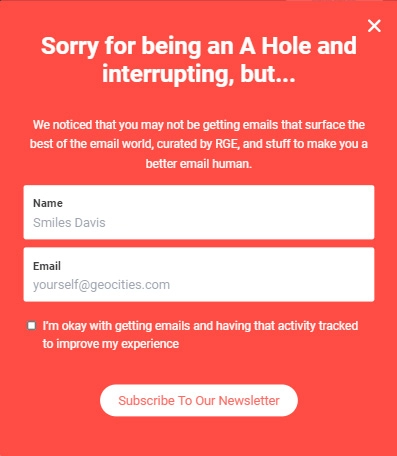
Pop-up notifications, like this, bring quite a few benefits to businesses that want to grow their inbound marketing strategy:
- Increase Conversion Rate – Pop-ups open another door for your potential subscribers to get to know your brand. Besides, if you choose the right time for your pop-ups to appear on your website, it will give an even bigger boost to your conversion rates.
- Target the Right Audience – Pop-up notifications appear for all the visitors that come to your website. But only those who are truly interested will subscribe. This way, you increase your chances of getting more engaged subscribers in your email list.
- Personalize the Customer Journey – Once a subscriber shares their email with you, they automatically become a member of an exclusive club, receiving personalized emails and custom offers. And, your expenses on perfecting the customer journey won’t set you back.
In the example above, you can see a very general example of a pop-up. Below, we’ll share with you a few other pop-up options that can help you target and engage your audience better.
2) Newsletter Sign-Ups
This is a great option for B2B businesses, like SaaS companies or writers services, for which newsletters are their primary type of content in email marketing. If you post regular industry updates or have an active blog, it makes sense to offer a newsletter subscription to your audience.
Search Engine Journal has a good example of a pop-up that collects email addresses because it also offers something in return:
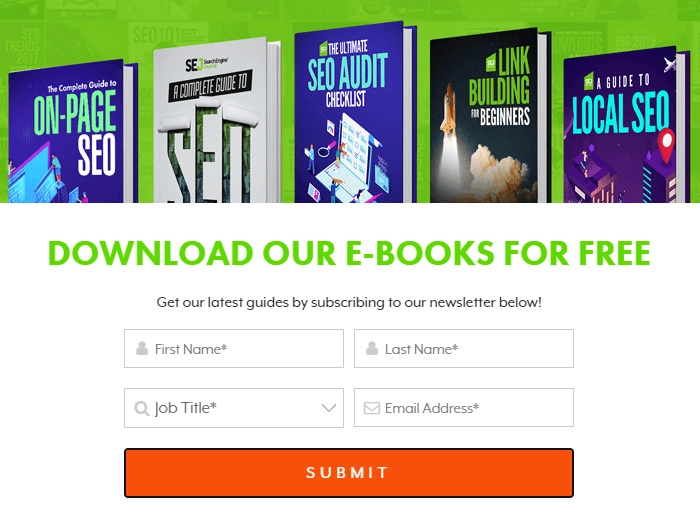
Apart from getting a general newsletter, SEJ subscribers also get access to its gated content – e-books, guides, and other resources only available through subscription. This is an effective way to collect subscribers because you offer something valuable in exchange for their email address.
3) Contests
If you want to diversify your pop-up game a little bit a move on from boring newsletter subscription notifications, you can use your pop-ups to launch a contest. Here’s a good example of such a pop-up from Highway Robery:
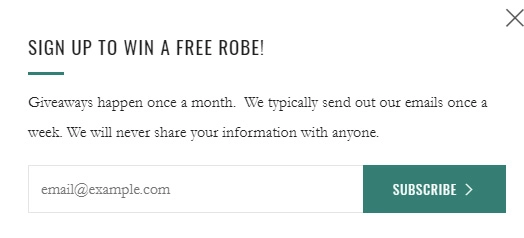
Such pop-ups have an immediate effect on the consumer in terms of engagement. Research by Sumo proves this point, saying that contest pop-ups have inherent value because they create personalization even before the subscriber shares their email address.
You can make so many variations of contest pop-ups – spin-the-wheel games, lotteries, or simple notifications, like the one you saw a bit earlier. All of them have one thing in common – they create value.
2. Segment Your Audience
If you’ve ever been subscribed to an online store that sells clothes, you’ve probably noticed that they usually send emails with product offers that suit your age and gender. Here’s an email from Rue La La that proves this point:

This is called audience segmentation, and it is an essential step in creating an effective inbound email marketing campaign.
An effective workflow is all about automation. Audience segmentation allows you to make this automation more effective by sending different emails that target different niches of your audience.
You can segment your audience using some of the following criteria:
- location
- age
- gender
- industry
- organization type
- education
- previous purchases
- interests
- buying frequency
- change in engagement level
- change in behavior
- satisfaction level
- referrals
- shopping cart or form abandonment
- CTA clicks
Of course, the way you choose to segment your audience will depend on the specificity of your brand and product. However, there are three main practices, without which you simply cannot do audience segmentation:
- An Email Segmentation Solution: When you have the subscriber list ready for your inbound email marketing strategy, you need to run it through a centralized software that will segment your list according to your preferences. Sure, you can do it manually, but only God knows how many hours it will take.
- Page-Level Targeting: Next, you need to set up page-specific campaigns with opt-ins for website visitors with specific behavior. Page-level targeting allows you to narrow down and segment your email list through behavior personalization.
- Creating Lead Magnets: This is something that you offer your subscribers in return for their email address. Gated content that we mentioned earlier is one of the variants of lead magnets used for audience segmentation.
Of course, you need to incorporate all these practices before you start sending out emails. If you want your inbound email marketing strategy to work, audience segmentation is crucial for the automation of the entire email workflow.
3. Break Down Your Email Workflow
Once you have your list of subscribers and audience segmentation ready, you can start the process of writing your emails.
Surely, now all emails are created equal. Each of them will serve its purpose and have its goals and objectives that you will also have to track to measure the performance of your inbound email marketing workflow.
With that in mind, your entire email workflow needs to be broken down into different campaigns based on your current marketing needs. Here are a few examples of such campaigns and the types of emails that these campaigns might include.
1) Welcome Campaigns
This campaign starts the onboarding process for the new subscriber – your potential customer. Your goal is to gradually introduce your prospects to your product, educate, and convince them to buy it.
For your welcome campaign, you can write the following types of emails:
- A Welcome Email– quickly greets a new subscriber and introduces your brand and product. The following example by Tidio, a chatbot company, also describes the benefits of their product, as well as has another essential feature for such emails – a CTA button:
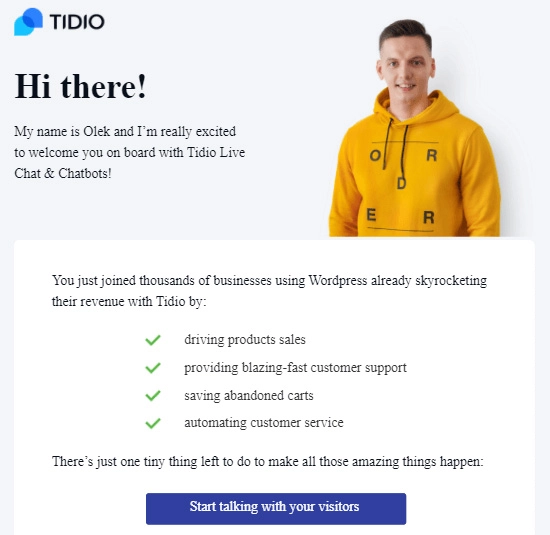
- A “how it works” email– further introduces the subscriber to your product. You can include an email like this in your inbound email marketing workflow if your product is complex and has a lot of features. Here’s an example of such an email from Twilio, a cloud communications platform:
- A FOMO Email– creates urgency, pushing the new subscriber to purchase your product. For example, the “End of trial” email, like the following one from Tidio, can be a good fit for a welcome campaign. It creates a sense of urgency while also providing the subscriber with the necessary steps to purchase the product:
2) Promotional Campaigns
If among your audience segments, you have subscribers who’ve been with you for a while, you can launch a promotional campaign to keep them interested in your brand.
The goal of this campaign can be to re-introduce your subscribers to your existing product or to announce the launch of the new one.
Depending on your product, you can include the following types of emails in your promotional campaign:
- Industry Updates – can include the promotion of new blog posts that are related to your company’s activity in the industry. This way, you not only share a piece of news but also promote your product. Here’s an example of such an email from Sumo:
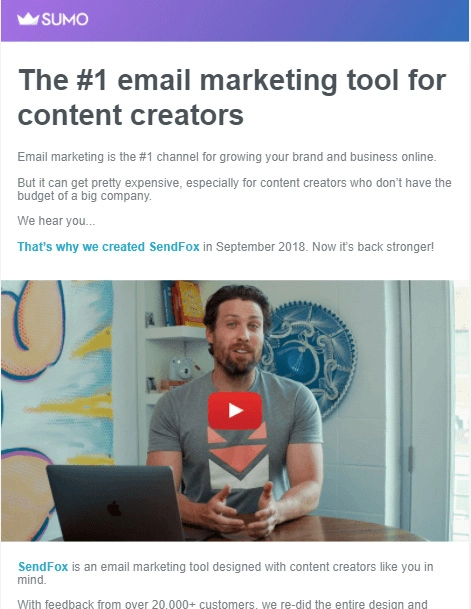
- A Case Study – shares real-life proof of how your customers benefit from your product. This email is great for promotion because it provides convincing evidence for your subscribers, pushing them to the right purchase decision. Here’s an example of such an email from Canva:
- New Product Announcement Email– notifies your subscribers about the upcoming new product and gives them early access to buying or pre-ordering it. Here’s an example of an email with a product announcement from the Wine Enthusiast Catalog:
3) Follow-Up Campaigns
This campaign is a good solution to re-engage your customers. Its goal is to remind your subscribers of your solution and push them to interact with your brand more.
In your follow-up campaign, you can include the following types of emails:
- Special Offer Emails– this email is especially effective to wake up dormant subscribers. By sending a special offer, you create a sense of urgency that re-engages dormant subscribers and pushes them to action. Limited-time discount emails, like the one below, are a good example that you can use in your inbound email marketing workflow as well:
- Abandoned Cart Emails– also work well to re-engage dormant subscribers who tried to purchase your product earlier but, for some reason, did not. Here’s a good example of such an email from Nomad:
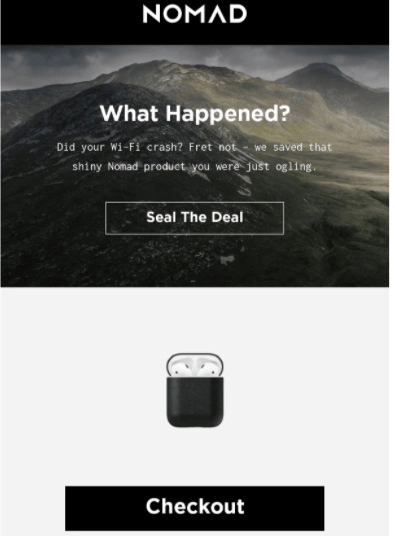
- Updates on Terms and Conditions– one more example of an email you can include in your follow-up campaign. This is important information that needs to be shared with every customer, but also serves as a non-intrusive reminder that they are subscribed to you. Here’s a simple example of such an email from Jysk:
These are, of course, only a few examples of emails for each of these campaigns. Depending on what your product or service is, you can add other types of emails to make your inbound email marketing workflow more diverse.
4. Consider Email Personalization
Another thing you need to consider when writing your inbound email marketing workflow is how you will address your subscribers in your emails. This is a good time to think about personalization as well before you automate your email workflow.
Personalization is important for lead nurturing as well as the overall performance of your email marketing campaigns. The more personalized your emails are, the more chances they have to be opened.
There are a few strategies you can employ to personalize all emails in your inbound email marketing workflow:
- Address Your Subscribers By Name – This is one of the most common ways to personalize your email. Addressing your subscribers by name immediately creates rapport and increases the chances that the email will be opened. You can automate this function using your customer relationship management software (e.g., Terrasoft) to have your emails appear like this:
- Send Your Emails at The Right Time – Another way to personalize your emails that goes beyond name is by targeting your audience when they are most active. Using your campaign tracking tool, analyze your audience’s behavior and determine the time when they check their inboxes. Then, use your email service provider to schedule your emails. Here’s how it looks in Gmail:
- Introduce Yourself– Many emails have one common drawback – they look like they were sent by a robot. If you want to add that human touch to your emails, introduce yourself, and personalize your business. You can do it by customizing your email signature with a photo, like in the example below:
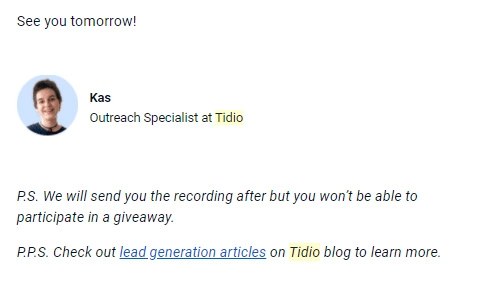
If you decide to commit to fully personalizing your emails, don’t just go with the email copy. Email subject lines also need personalization because they are the first thing a subscriber sees in the inbox. So, make sure you personalize your inbound email marketing workflow at every level to achieve maximum results.
5. Mind the Length of Your Emails
Since we started speaking about writing an email copy, let’s take a look at how long it should be to make sure you don’t bore your subscribers with too much information.
There are a few rules regarding the length of different components in an email copy:
- Email Subject Lines – 15 characters. Brian Dean, the founder of Backlinko, says that the optimal length of an email subject line is 1 characters. According to him, short subject lines have considerably higher open rates.
- Email Copy – 50-125 words. After studying hundreds of emails and their performance, Campaign Monitor has determined that the ideal length of the email copy should not exceed 125 words. And, email copies that are 50 to 25 words long have response rates over 50%.
- CTA – Up to 10 Words. According to the CrazyEgg guide, a call-to-action that has more than 10 words is already too long. The length of a CTA impacts its readability. The longer it is, the lower are the chances that the subscriber will click on it.
Since the inbound email marketing workflow is all about automation, keep these email length characteristics in mind when writing the emails for your campaigns.
Wrapping Up
So, what’s the ideal formula for writing a good inbound email marketing workflow?
First, set up the solutions to collect emails and create a list of subscribers.
Then, segment your audience based on the criteria relevant to your product and business.
After that, create different campaigns within your workflow. Define goals and objectives that you will track when your workflow is already up and running.
Also, don’t forget to employ personalization tactics that will make your emails more targeted.
And lastly, for the sake of better engagement, mind the length of your email copy to make sure it contains only the essential information.
That’s it!
Hopefully, these steps will help you create your own inbound email marketing workflow. And, if you find it hard, you can use this guide at any time to help you out!
Our blog
Latest blog posts
Tool and strategies modern teams need to help their companies grow.

This comprehensive guide covers everything about service marketing—its unique chara...

Believe it or not, the concept of content sharing existed long before the Internet. I...

Sales analysis is essential to avoid inaccurate forecasts and identify improvement op...




